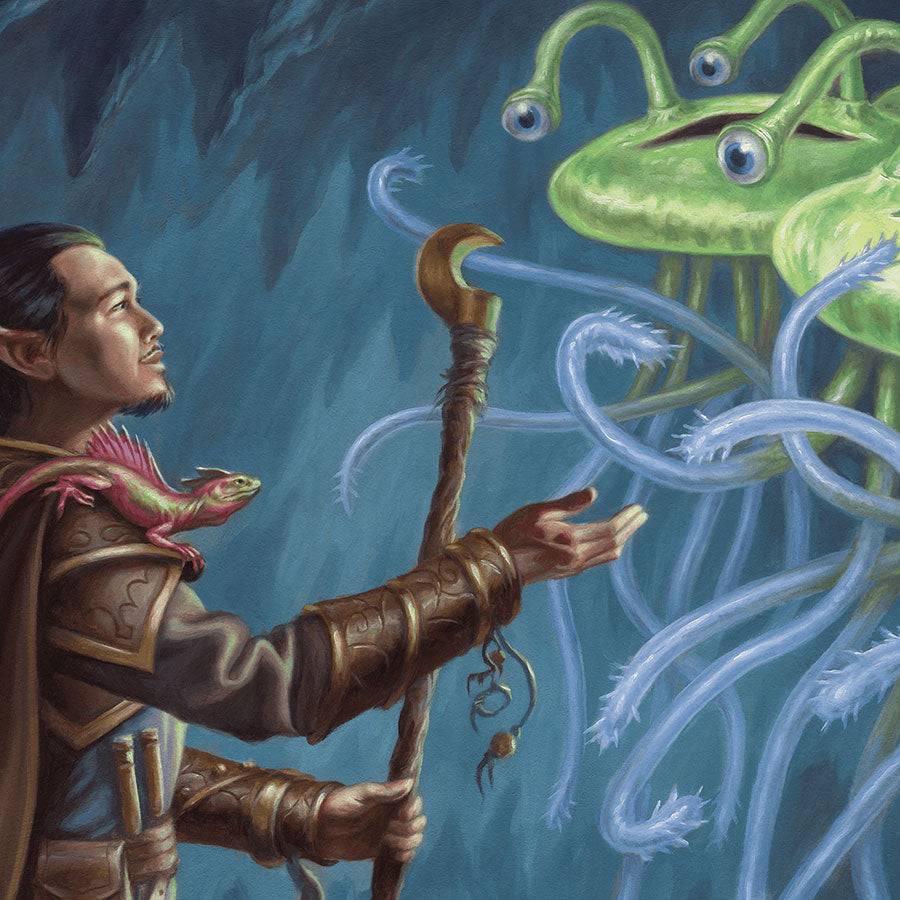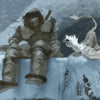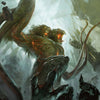The 5 Reasons TPKs Happen in D&D

Written by Luke Hart
Let’s talk about total party kills (TPKs) in D&D, and why they are almost always 100% the fault of the players. Yes, game masters can be cruel heartless jerks sometimes, but in my experience as a GM, TPKs are usually the players’ fault.
Watch or listen to this article by clicking the video below.
Splitting the Party
Let’s start off with the most obvious one, shall we? Get Captain Obvious out of the way. “Never Split the Party” is one of the most common sayings in RPGs that almost every player recites daily just to make sure it stays top of mind. And yet, it happens time and time again in my game sessions that players are like, “I think we should split up…” And then a heated discussion occurs with players going back and forth about why they should or should not split up.
USUALLY, they decide not to, but what tickles me is that they are actually considering it. My players know that if they split up, I’m not going to be adjusting ANYTHING in the adventure or encounters just because there are only TWO characters when they come across an encounter designed for a group of FIVE characters. For me personally, that would break verisimilitude if I adjust things on the fly to account for them splitting up. A dungeon is the way a dungeon is, and the reality of that dungeon is NOT affected by player decisions.
I will also say that I have had some AMAZING game sessions where characters have split up and encountered creatures way above their pay grade. In my Sword Coast Guard game, my player Trevor once had his character – a spellcaster, I believe – sneak down into the crypts below Gauntlet Hall while the rest of the party distracted the Knights of Torm by pretending to want to join their order. This resulted in tension and anticipation – and I’m sure a bit of fear – that was actually tons of fun.
Trevor provoked a fight with a construct that was mostly immune to his magic, and he had to flee for his life. It was the adrenaline rush you get when you skirt death and destruction, knowing that something horrible might just happen. And then if they get out of it alive – which Trevor’s character did – wow, the feeling of relief and jubilation is spectacular. So maybe this is why players want to split the party? At the very least, it is ONE REASON I don’t adjust adventures when they do so.
Bad Decisions
Speaking of my Sword Coast Guard group, they once decided to take on an entire castle full of enemies all at once. Okay, context: they wanted to sneak into the castle in order to head-hunt the leaders and not have to fight everything. Well, on the way to the castle, they flubbed a skill challenge, and a patrol of orcs managed to sound their horn and alert the castle to the presence of intruders. This, naturally, put the entire castle on alert, and they began actively searching for the intruders.
As a game master, I figured, hey, the solution is simple: retreat and come back the next day when things have died down. But, no, my players decided that there was no time like the present and pushed forward with the entire castle on alert. Now, they DID manage to sneak into the castle itself, but it was only a matter of time before they ran into a group of orcs and battle ensued. And, naturally, the enemies yelled out that they had found the intruders – they may have even sounded their own horn – which in turn caused many of the enemies, including the leaders, to converge upon the characters.
So, basically, my players took on an entire castle full of orcs – and their powerful leaders – all at once. Now, your first reaction may be, “Gee, that sucks.” But let me tell you, that game session was AMAZING! It was so much fun for all of us. And my players ALMOST WON! All of the orcs and characters were dead except for ONE orc leader and ONE character, and they were duking it out 1 on 1. It was super close, but the orc leader won, and the last character fell.
Now, you may be saying, “Luke, why didn’t you just adjust the orc’s hit points or have them miss the PC or something? Why didn’t you engineer it so the character could win?” Because that would have CHEAPENED the experience, and it would have prevented the players from rolling up new characters who would go back to the castle, trounce their foes, and ultimately win. You see, a REVENGE MISSION is tons of fun, too.
By the way, if you’d like to watch that game session, it’s right here on my channel: Snagjaw Castle Part 2.
Leaving Enemies Alive Behind You
And the players of my Hand of Light group have happily volunteered to serve as a case study for this top reason for TPKs. If I remember correctly, because this was several years ago, they were down in some crypts searching for the captured mother of one of the characters. They ran across a group of undead, and the cleric used turn undead, which caused all of the undead to run off in fear. The players were like, “Yay, we won,” and then continued moving through the crypts.
Of course, turn undead only lasts for a minute or so, after which point the undead – who were being led by intelligent leaders – began coming after the characters again, following them from behind. Now, some of the undead were playing musical instruments, too, so I even told the players two or three times that they still heard the music behind them and it seemed to be following them. So, they KNEW something was up…but they continued to press forward.
It was at this point that they ran into another encounter, and battle began. On the second round or so, the musical undead arrived to their rear, and the characters found themselves sandwiched between two groups of enemies. Character after character began to drop, and the last living PC tried to flee and hide, but the baddies got him, and it was a TPK.
The interesting thing is that this is a reoccurring theme I see in my games. There is a desire on the part of the players to bypass encounters and beeline for the boss or the objective, which is completely understandable: why fight stuff when it can be avoided? However, those bypassed encounters aren’t always dealt with in the best ways – ways that would better ensure they don’t become issues in the future. Instead, the thought is sometimes to circumvent mook encounters by any means necessary, and just hope and pray the enemies in them don’t come back to bite you later.
You see, as a game master, I’m not trying to stab my players in the back or screw them over; but I am trying to run realistic and believable games, and if bypassed encounters are not satisfactorily dealt with, I’m not going to just handwave things.
Taking on Multiple Encounters at Once
Now, technically, my previous two stories about my Sword Coast Guard group and Hand of Light group illustrate this point, but I also once had a player with a habit of OPENING DOORS when the group was already in the middle of combat. This sometimes resulted in additional groups of enemies joining the battle, which caused the combat to become extremely challenging.
Now, sometimes adventures are designed with this in mind. For instance, I often design things so that there are a few groups of enemies in nearby rooms, and starting battle with any one of them will cause the other baddies to arrive on the next round. But those encounters are DESIGNED that way, and other encounters are just not meant to be taken on simultaneously.
In the particular case of this player who went around opening doors in the middle of combat, he was actively TRYING to “wake up” additional encounters and bring them down on the group. I didn’t even realize this until my buddy Joe came to me and was like, “Hey, Luke, you know that he’s doing that on purpose because he’s upset and wants to screw us over, right?” So, yeah, I had a conversation with that player, and let’s just say that there was no more opening of doors in the middle of combat.
And what’s my point? Sometimes TPKs happen because there is a nefarious actor in your midst, and that’s not cool, and it must be dealt with.
Lack of Teamwork
And now we shall turn to my Youngling Group – a group of teenagers I run a game for – to illustrate this point. They were tracking down a criminal known as the Black Mage, who was a CR 15 skull lord, a creature that would have certainly been a challenge for them. They confronted the Black Mage, and two of the players were trying to convince him not to fight; they were trying to convince him to take one of the characters as his queen. I’m not sure how that would have helped them fulfill their contract to apprehend the criminal, but they stuck with it.
In fact, so determined were they, that even after the battle with the Black Mage began, instead of fighting, they continued trying to convince him. Meanwhile, the other two players were fighting back because they knew the gig was up. So, here we had the Black Mage laying down cones of cold, cloudkill, and other nasty spells – and two players were still engaged in diplomacy while the other two were doing their best to fight back and not die.
Finally, two of the players – the ones who were actually fighting – saw the writing on the wall and decided to flee, leaving the other two players – who STILL weren’t fighting – behind to die…which they did in short order. Of course, the Black Mage had access to the spell dimension door, which he used to cut off the two fleeing characters. And that was my Youngling Group’s first TPK.
Now, one might point out that several things went wrong here, but ultimately it came down to a lack of teamwork against a powerful foe.
The Ultimate 5e Anthology for DMs
Lairs & Legends 2 and Loot & Lore 2 are the ultimate game master resource! These two massive books put an anthology of everything you need to run amazing games for YEARS at your fingertips.
- Over 30 Adventures
- 30 Stand-Alone Encounters
- More than 100 Monsters
- Traps and Puzzles
- 6 New Rule Sets
- And much more!
These books are written to make running the game easy for new and veteran GMs. Each resource is built with intuitive formatting, clear wording, and evocative art. You’ll never again have to dig through dense paragraphs to find critical details you need during a live session.
These 5e resources are designed to scale to your needs, whether it’s a quick drag-and-drop trap to add some spice to your session or complete adventures that span levels 1 to 20. The sky’s the limit with what your games can become with Lairs & Legends 2 and Loot & Lore 2.
-
Posted in
Game Master How-To Articles






